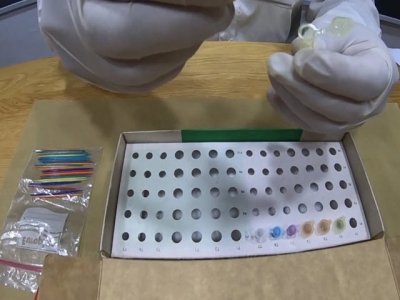Rapid SRS detection kit launched

A recently developed on-farm detection kit for piscirickettsiosis (SRS) can confirm the bacteria’s presence within 90 minutes and might help reduce the impact of a disease that costs the Chilean salmon industry $750 million a year.
The lateral assay kit has a control line (C) and a test line (T) that are not visible before running the test. Line C is a process control, so a pink line should always appear if the test was successful. A pink line will be visible on the T line when the analysed sample contains P. salmonis
Piscirickettsia salmonis is the bacterial agent causing piscirickettsiosis (SRS), a disease responsible for direct (fish mortalities) and indirect (eg degrading quality due to skin injuries, antibiotics) losses that cost the Chilean salmonid farming sector up to $750 million per year.
Three decades have passed since these bacteria were first discovered in Chilean salmon and there is no successful vaccine yet against either of its two most frequent strains (LF-89 and EM-90). Subsequently, most treatments involve the antibiotics florfenicol or oxytetracycline. However, use of different preventive measures in recent years, such as probiotics, and improved smolt quality and farming practices, have helped to reduce antibiotic dependence.
Now, there is an on-farm detection kit available, which can diagnose the disease within 90 minutes, without lab equipment or highly qualified staff. Moreover, these portable kits reduce the number of trips from sites to labs for analysis, and therefore help farms maintain social distancing during the Covid-19 pandemic.
On-farm kit
WikiGen SRS is a molecular kit for the qualitative detection of P. salmonis by means of an isothermal nucleic acid amplification method with polymerases and recombinases, followed by development by lateral flow assay.
Marco Rozas, founder and technical director at Newenko Group, the company that developed the test, commented that this kit is much more rapid than sending a sample to a laboratory and can lead to timely and effective treatment and thus reduce mortalities.

The kit is used on soft tissues such as liver or kidney. A sample of 0.1 to 0.2 cm3 is required for analysis
“You can obtain results after 90 minutes with WikiGen, versus 7,200 minutes in a lab. Then, if you treat quickly, there are more chances for the fish to consume medicated feed, which increases the possibility of obtaining an effective therapy. By contrast, if you arrive late, the fish have lost their appetite and in-feed treatment is wasted. The medicated are also more likely to pass into the marine sediment,” he explains.
According to Rozas, compared to lab analysis using techniques such as Elisa and PCR, this kit detects SRS with 91 percent of sensitivity and specificity, and an accuracy of 90 percent. It is also able to recognise both LF-89 and EM-90 strains.
“What is most significant in the current pandemic, is that this kit can be used by any official or technician at the farm, thus providing an effective and efficient solution and allowing control measures to be applied in a timely manner,” Rozas says.
Related news
 Gloomy prospects ahead for tuna exports to major markets
Gloomy prospects ahead for tuna exports to major markets Vietnam’s tuna exports to major markets such as the US and EU suffered a decline of 20% in the first half of the year due to the impact of the COVID-19 pandemic
 A magnetic solution to top quality Artemia
A magnetic solution to top quality Artemia Improving the quality of Artemia used in hatcheries has been made possible by a series of new tools launched by INVE Aquaculture.
 Salmon sector faces scrutiny over seal deterrents
Salmon sector faces scrutiny over seal deterrents The Scottish salmon farming sector is to review the use of acoustic devices deployed on farms to deter seals.